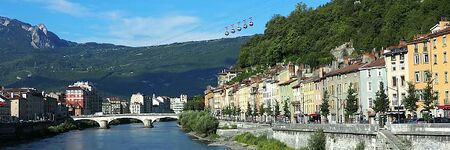Grenoble France
- Members
Grenoble is the prefecture and largest city of the Isère department in the Auvergne-Rhône-Alpes region of southeastern France. It is located within the Dauphiné historical province and lies where the Drac and Isère rivers join at the foot of the French Alps.
Activities

|
BigClouT | |
BigClouT project aims at giving an analytic capability to cities exploiting available big data from sources such as IoT devices, open data, social networks, mobile applications, etc. and use them to improve the daily life of cities, their citizens and visitors. The target applications are:
| ||
Details
The population of the commune of Grenoble was 158,180 at the 2016 census, while the population of the Grenoble metropolitan area (French: aire urbaine de Grenoble or agglomération grenobloise) was 687,985 which makes it the largest metropolis in the Alps, ahead of Innsbruck and Bolzano. A significant European scientific centre, the city advertises itself as the "Capital of the Alps", due to its size and its proximity to the mountains. The many suburb communes that make up the rest of the metropolitan area include four with populations exceeding 20,000: Saint-Martin-d'Hères, Échirolles, Fontaine and Voiron.
Grenoble's history goes back over 2,000 years, to a time when it was a village of the Allobroges Gallic tribe. It became the capital of the Dauphiné in the 11th century.[9] This status, consolidated by the annexation to France, allowed it to develop its economy. Grenoble then became a parliamentary and military city, close to the border with Savoy. Industrial development increased the prominence of Grenoble through several periods of economic expansion over the last three centuries. This started with a booming glove industry in the 18th and 19th centuries, continued with the development of a strong hydropower industry in the late 19th to early 20th centuries and ended with a post-World War II economic boom symbolized by the holding of the X Olympic Winter Games in 1968.
The city has grown to be one of Europe's most important research, technology and innovation centres, with one in five inhabitants working directly in these fields. Grenoble is classified as a global city with the ranking of "sufficiency" by the Globalization and World Cities Research Network. The city holds the title of European Green Capital in 2022.

